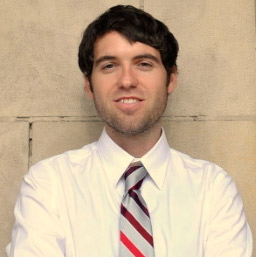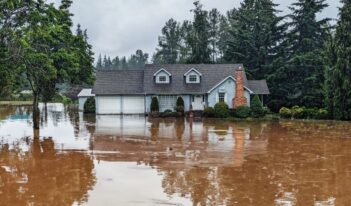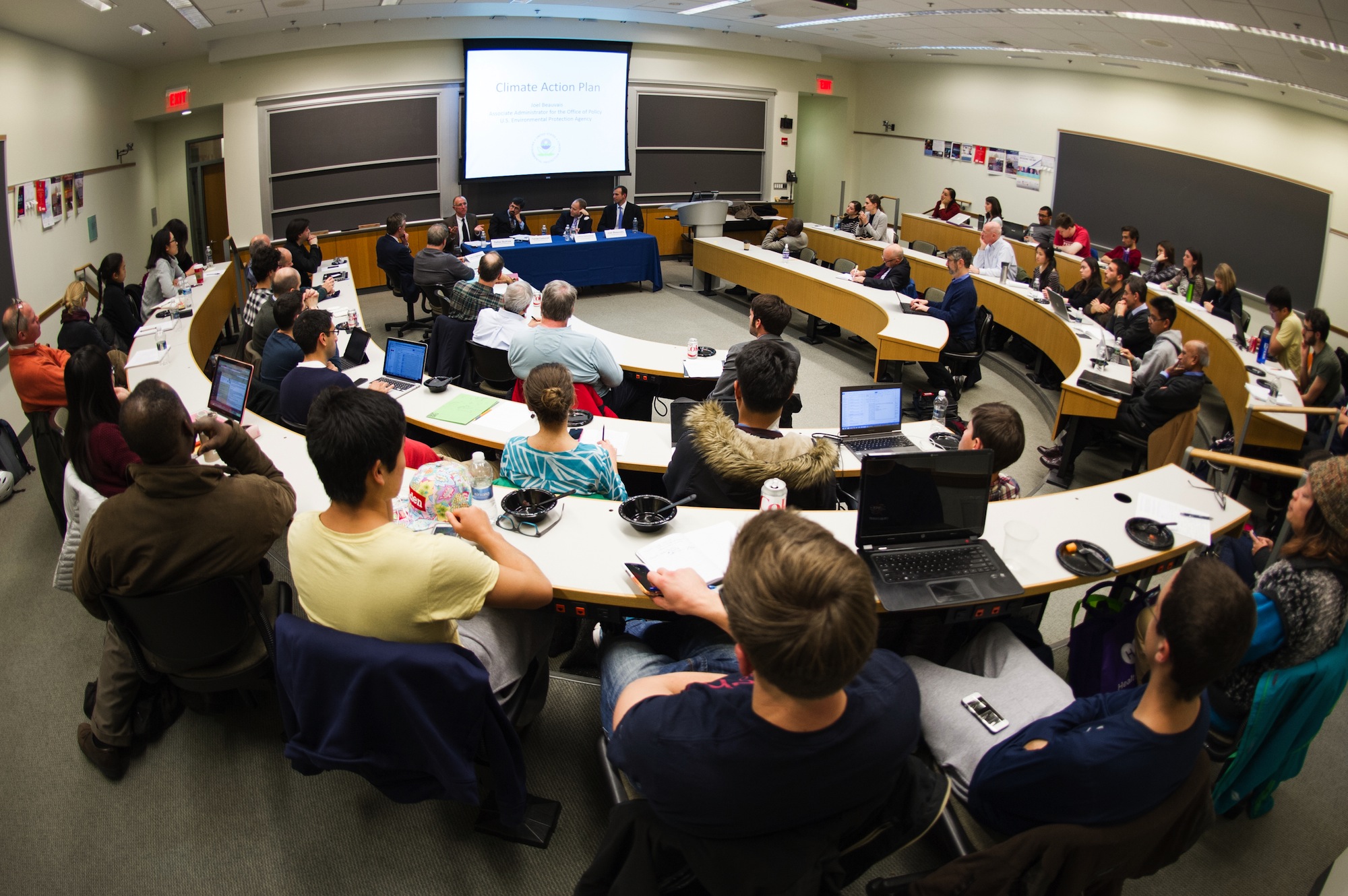
PPR seminar focuses on controversial proposed rule aimed at combatting climate change.
In the wake of a groundbreaking agreement between China and the United States to reduce greenhouse gas emissions, climate change action appears to be gaining political momentum in the lead-up to a major international climate meeting in Paris in 2015. The agreement with China commits the United States to a variety of initiatives to promote innovation and echoes President Obama’s “Climate Action Plan” in setting an ambitious goal to reduce economy-wide emissions by 26-28 percent of 2005 levels by 2025.
Less appreciated—and certainly less headline grabbing—have been the efforts that the U.S. Environmental Protection Agency (EPA) and other regulatory agencies have already been making to address climate change. In addition to jointly promulgating a rule with the U.S. Department of Transportation to address fuel economy standards in motor vehicles and working on a program to reduce methane emissions from a variety of sources, the EPA has also targeted the largest emitters of carbon dioxide in the United States—existing and future power plants—in its proposed “Clean Power Plan.”
The Clean Power Plan has become one of the core environmental initiatives of the second term of the Obama Administration, but it has also been subject to a good deal of controversy despite unprecedented public outreach by the EPA and the submission of about 1.5 million public comments. To help inform the public and consider some of the issues raised by the proposed plan, the Penn Program on Regulation recently convened a panel discussion as part of its monthly Risk Regulation Seminar Series.
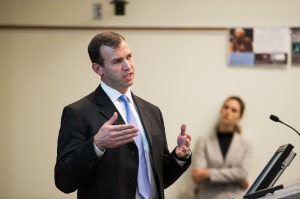 Starting the conversation, Joel Beauvais, current Associate Administrator for the EPA’s Office of Policy, presented an informative outline of the EPA’s climate change initiatives, focusing particularly on the Clean Power Plan proposal.
Starting the conversation, Joel Beauvais, current Associate Administrator for the EPA’s Office of Policy, presented an informative outline of the EPA’s climate change initiatives, focusing particularly on the Clean Power Plan proposal.
The EPA’s proposed power plant rule aims for a 30 percent reduction in energy-sector emissions from 2005 levels. One of the most notable aspects of the proposed rule lies with how it is supposed to achieve those goals. Relying on a relatively obscure part of the Clean Air Act, the EPA proposes to set state-specific goals for improving the carbon intensity rate (or pollution-to-power ratio) in energy production, and then turn responsibility to the states to put together plans to achieve the “best system of emission reduction” in light of the interconnected nature of power generation. States would have flexibility to achieve their targets in whatever way they see fit, whether that is improving efficiency at coal power plants, encouraging the use of low-emitting or zero-emitting sources, such as natural gas, solar, and nuclear, or even encouraging “demand-side,” or consumer-end, energy efficiency.
EPA’s modeling has estimated the benefits of the proposed rule at between $55 and $93 billion, far outweighing the costs, which the agency has estimated at $7.3 to $8.8 billion by 2030. But these numbers have been questioned, particularly by industry representatives.
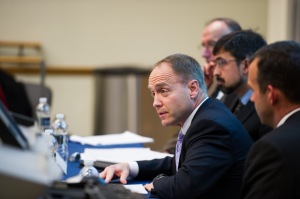 At the PPR seminar, Jeffrey Holmstead, a former Assistant Administrator for EPA’s Office of Air and Radiation and now a lawyer representing industry, argued that most of the benefits identified by EPA are not directly related to mitigating the risks of climate change. He said that the large estimated benefits that EPA has computed stem instead from reductions of fine particle pollution and other side-effect benefits having nothing to do with climate change.
At the PPR seminar, Jeffrey Holmstead, a former Assistant Administrator for EPA’s Office of Air and Radiation and now a lawyer representing industry, argued that most of the benefits identified by EPA are not directly related to mitigating the risks of climate change. He said that the large estimated benefits that EPA has computed stem instead from reductions of fine particle pollution and other side-effect benefits having nothing to do with climate change.
Holmstead also noted that, although the reductions in carbon dioxide emissions anticipated under the EPA’s proposed rule might look impressive, the reductions it would achieve even when fully implemented in 2030 would amount to just a few days’ worth of emissions in China. He also argued that, in most parts of the world, carbon-based energy is the least expensive way to generate electricity and fuel transportation, and that, unless there are breakthroughs in energy technology, any effort to decrease the reliance on carbon will have significant economic consequences.
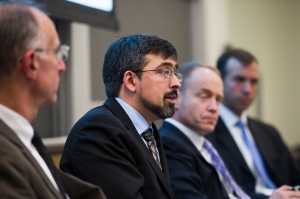 Tomás Carbonell, an attorney with the Environmental Defense Fund, argued that EPA’s proposed rule builds on recent trends in the power sector, including the increasing deployment of clean energy resources and a downward trend in the use of coal that has led to a 20% reduction in coal-fired energy generation over recent years. Moreover, the unique structure of the proposed rule, with its flexible state-portfolio approach, could ultimately support the development of regional cooperation, Carbonell noted. He pointed to the Regional Greenhouse Gas Initiative in the Northeast as one possible model for the states, arguing that its cap-and-trade system has resulted in substantial cost-effective successes in reducing emissions.
Tomás Carbonell, an attorney with the Environmental Defense Fund, argued that EPA’s proposed rule builds on recent trends in the power sector, including the increasing deployment of clean energy resources and a downward trend in the use of coal that has led to a 20% reduction in coal-fired energy generation over recent years. Moreover, the unique structure of the proposed rule, with its flexible state-portfolio approach, could ultimately support the development of regional cooperation, Carbonell noted. He pointed to the Regional Greenhouse Gas Initiative in the Northeast as one possible model for the states, arguing that its cap-and-trade system has resulted in substantial cost-effective successes in reducing emissions.
Dallas Burtraw, an economist with the think tank Resources for the Future and a foremost authority on environmental regulation of the power sector, likewise emphasized the need for regional cooperation if the EPA’s rule is to work successfully. The complexities of the nation’s energy system, with power grids that typically cut across state lines, mean that states will need to cooperate rather than seek to shift burdens onto their neighbors. To address what he called the “fundamental coordination problem” underlying climate change efforts, Burtraw suggested that more comprehensive approaches such as national legislation or international treaties will ultimately be needed. Until then, he sees the success of the EPA’s proposed rule largely depending on the willingness of states to engage in regional cooperation.
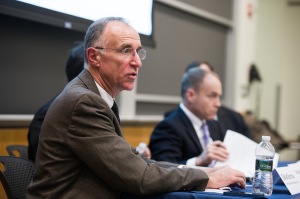 The PPR panel discussion made clear that EPA’s proposed rule will face nearly certain legal challenges after it is adopted. Even if the rule itself withstands initial scrutiny by the courts, its implementation may also face additional legal obstacles if states fail to submit plans that EPA finds sufficient and if the agency tries to compel states to do more.
The PPR panel discussion made clear that EPA’s proposed rule will face nearly certain legal challenges after it is adopted. Even if the rule itself withstands initial scrutiny by the courts, its implementation may also face additional legal obstacles if states fail to submit plans that EPA finds sufficient and if the agency tries to compel states to do more.
Even if the EPA ends up losing in court and the rule is struck, it may still achieve its intended objectives. As Burtraw noted, some analysts have suggested that a win for industry in court might actually lead EPA in the future to rely on more traditional, legally firmer approaches to pollution control than the more flexible, if legally innovative, approach it has proposed.
More immediately, the proposed rule may help increase the prospect for a breakthrough in the ongoing international negotiations over climate change, particularly in the lead-up to the Paris summit in 2015. The proposed rule may help provide a credible signal to partners abroad that the United States is serious about taking steps to mitigate the risk of climate change.
PPR ’s Risk Regulation Seminar series is co-sponsored with the Wharton School’s Risk Management and Decision Processes Center, its Initiative for Global Environmental Leadership, and the Kleinman Center for Energy Policy at PennDesign.

